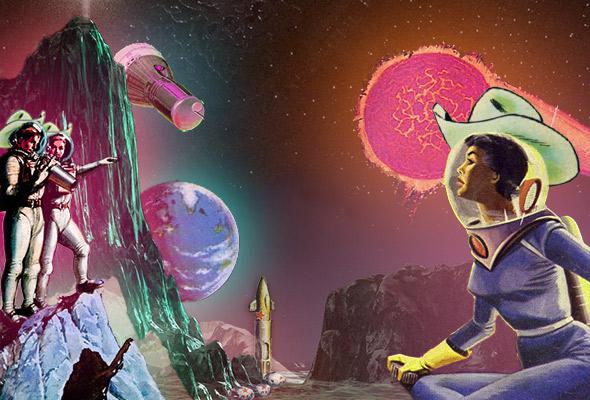It will take 10 years, but we are headed back to the moon! Lunar Mission One, heralded (well, by its creators) as the most inspirational lunar project since Apollo, will send a landing module to the moon’s as yet unexplored south pole. An innovative robotic probe will drill 65 to 328 feet beneath the lunar surface, “un-mooning” 4.5 billion-year-old rock in an effort to discover the moon’s geologic makeup and origins, its relationship to our earthly home, and the possibility of human habitation.
One intriguing aspect of this mission is the plan to bury a 21st-century time capsule. It will hold a publicly compiled digital record of life on Earth—the “public archive”—and millions of individual “digital memory boxes,” each containing messages, photos, videos, and a physical space for a non-digital memento: a strand of hair. These earthly treasures will be deposited at the base of the borehole, which will subsequently be sealed.
To fund this ambitious $1 billion moonshot, London-based Lunar Missions Ltd. has turned not to the British government, the European Space Agency, or NASA, but to the crowdfunder Kickstarter. A donation of as little as $24 earns a certificate of thanks; for close to $8,000, your reward is a spot in the viewing gallery at mission control to watch the spacecraft land. A digital memory box—available for personal use or as a one-of-a-kind holiday gift—will run about $100. The goal in the Kickstarter funding phase is to raise close to $1 million for initial project management and program planning. The major marketing and sales campaign for the additional $999 million will launch in 2019.
As with the recent touchdown of the European Philae lander on Comet 67P, Lunar Mission One has clearly sent imaginations soaring and reignited a smoldering enthusiasm for space exploration. With 14 days to go, about 5,000 backers have pledged two-thirds of the million-dollar goal. We have fallen back in love with the moon.
The effects of landing, drilling, and burying a time capsule are largely unknown—and perhaps unknowable in advance. Recognizing this, the upcoming decade should be dedicated not only to raising funds and developing the lander and drill, but also to considering ethical guidelines that we should follow as we head back to the moon.
As an ethical kick-start, I propose these three guiding principles:
No. 1: We value the moon for its own sake and protect its natural state while studying and learning from it.
No. 2: We seek to avoid contamination of the moon as well as reverse contamination from the moon to the Earth.
No. 3: Recognizing that we don’t know what we don’t know, we exercise prudent vigilance in determining what goes to, resides on or in, and returns from the moon.
Prudent vigilance asks us to think carefully about processes for measuring safety, security, and environmental impact before, during, and after a space mission, and comparing them with the possible benefits of a mission. How does a deeper understanding of the origin of the moon measure up against concern for human safety, security of memory box information, and the environmental impact of drilling, extracting lunar samples, and depositing the time capsule? What could possibly go wrong with a mission to deposit earthly artifacts on the moon? We don’t know, and that is precisely the point; we need to find out. We should be mindful that explorations here on Earth, however well-intentioned, have upset ecological balance, reduced biodiversity, destroyed habitat, and spread alien diseases to native species. We should guard against a repeat of unintended consequences in space.
A reliable and transparent decision-making process will help us assess risks as new technologies are developed and disseminated, and it will help us draw limits if the probability of significant, irreversible damage is too high. Far from caution-induced paralysis, prudent vigilance engenders responsibility while moving forward in space exploration.
The moon is currently home to a myriad of human artifacts. Called “lunar assets” by NASA and “rubbish” by others, the lunar surface is dotted with golf balls, tools, abandoned modules, and the like (but not bags of vomit). NASA wishes to preserve these—together with footprints and rover tracks—as testaments to human achievement, similar to protecting prehistoric petroglyphs or the Acropolis from the ravages of time. How should we think about the possibility of digital memories and human hair interred beneath the lunar surface—assets or rubbish?
No governments or public space agencies are currently involved in Lunar Mission One. The funding of space exploration has shifted from public to private, from NASA to SpaceX. Although there is a vital role to be played by the private sector, as there has been from the beginning, government funding strengthens accountability and provides public oversight. Isn’t taxpayer funding of space exploration the ultimate in crowdsourcing? It gives us all—not just those who buy a memory box—a stake and a say in how we learn about the moon, the solar system, and ourselves without the need to bury photos, videos, and human DNA beneath the lunar surface. As we remember Apollo and dream of going back to the moon, we should support robust government funding of space exploration and the vigorous renewal of public-private partnerships in science—with an eye always on prudent vigilance.
